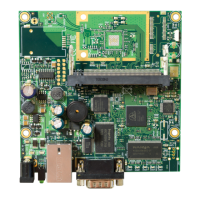RouterBOARD 411 Series User's Manual
See Connector Index for pinout of the standard cable required for PoE. All cables made to EIA/TIA 568A/B
cable specifications will work correctly with PoE. Note that this port supports automatic cross/straight cable
correction (Auto MDI/X), so you can use either straight or cross-over cable for connecting to other devices.
DB9 Serial Port
The RS232C standard male DB9 asynchronous serial port may be used for initial configuration, or for
attaching a modem or any other RS232 serial device. TxD (pin 3) of this port has -5V DC power when idle.
RTS and DTR signals are not connected. Note that the device does not fully implement the hardware (RTS/
CTS) flow control, so it is suggested to try to disable hardware flow control in the terminal emulation
program in case the serial console does not work as expected, and if it does not help, make a new cable
using the pinout given in the User's manual.
LEDs
Power LED
Power LED is on when the board is powered.
User LED
User LED may be programmed at user's option. It is lit by default when the board starts up, then it is turned
off when the bootloader runs kernel.
Status LEDs
Five LEDs (LD 501-505) may be used to show bootup activity, wireless signals, and user programmed
values.
User's Guide
Assembling the Hardware
First to use the board:
● Insert MiniPCI cards and connect antenna wires, if needed;
● Install the board in a case;
● Connect other peripherals and cables.
Powering
Power options:
● J801 power jack:
10..28V DC (supports overvoltage protection)
● Power over Ethernet (PoE) on the J602 LAN1 Ethernet port:
10..28V DC (18..28 V suggested) non-standard PoE powering support
The board has a direct-input power jack J801 (5.5mm outside and 2mm inside diameter, female, pin
positive plug) and can as well be powered with PoE. All power inputs are always active, but only one should
be used at the same time.
RouterBOARD 411 is equipped with a reliable 14W onboard power supply with overvoltage protection. 9..28
V DC input voltages are accepted, but when powered over long cables, it is suggested to use at least 18V.
The system is tested with 24V solar/wind/RV systems with 27.6 charge voltage. Overvoltage protection
starts from about 28V (up to 100V), so the board will not be damaged if connected to a 48V or 60V power
line.
RouterBOARD 411 series boards are compatible with non-standard (passive) Power over Ethernet injectors
(except power over datalines) and accept powering over up to 100m (330 ft) long Ethernet cable connected
to the Ethernet port (J602). The board does not work with IEEE802.3af compliant 48V power injectors.
The maximum output of the power supply to the extension cards is normally at about 3.3A
5

